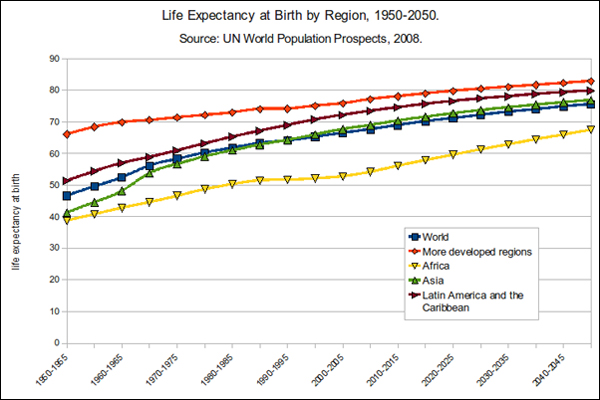
What Is The Record For The Oldest Person?

On August 4, 1997, Jeanne Calment passed away in a nursing home in France. She died at age 122, the longest verified life for a woman and a record for all human longevity. Her picture at 122 is shown at the left. The second verified oldest was Sarah Knauss of the USA who lived for 119 years. The oldest man was Jiroemon Kimura of Japan, who was 116 years old and the 15th oldest person ever. The previous oldest 14 people were all women. The current oldest "living person" is Jamaican woman Violet Brown, who is 117 years old. (Source of age information: Wikipedia.)
A child born in the United States in 1900 had an average life expectancy just short of 50 years. An American male child born in 2016 on average can expect to live to age 76, a female child can expect to live to 81. The average expectancy for both males and females is 79 years. Japan’s average life expectancy at birth has risen to 83 years, the highest of any country.
In 2010, there were 80,000 centenarians in the US, 85 percent of them were women, and only 15 percent were men. It is not clear what's causing this disparity. Theories include the protective role of female sex hormones, lower rates of cardiovascular disease for women, and higher smoking rates among men. Men also have higher rates of car accidents and suicide.
However, the survival gap is gradually narrowing. Possibly because women are now living lives that are conventionally male in terms of stress and health habits. One bit of good news for men: Those who do reach the century mark are on average, healthier and more functionally fit than their female counterparts. Top
Life Expectancy

Life expectancy is a measure of the average time a human is expected to live based on the year of their birth (life expectancy from birth, LEB for short), their country, and other demographic factors including sex (women live longer than men). The LEB chart at the left shows a 100 year span from 1950 to 2050. The data from 2008 on are projections by the UN. The yellow line on the bottom is for Africa and the red line for developed countries.
In the Bronze Age (-3300 BC to -1500 BC), life expectancy was only 26 years, about the same as our nearest relative - the chimpanzee. The 2010 world LEB was 67.2 years. For recent years, in Swaziland, Africa, LEB was about 49 years, but in Japan, it was about 83.
The combination of high African infant mortality and deaths in young adulthood from accidents, epidemics, plagues, and childbirth (particularly before modern medicine was widely available) significantly lowers the African LEB. But for those who survived the early hazards, a life expectancy of 60 or 70 is not uncommon. For example, a society with a LEB of 40 may have few people dying at precisely 40: most will die before 30 or after 55. Because of this sensitivity to infant mortality, LEB can be subjected to gross misinterpretation leading one to believe that a population with a low LEB will necessarily have a small proportion of older people. An example, in a "hypothetical" population in which half the population die before the age of five but everybody else dies at exactly 70 years old, LEB will be about 36, but about 25% of the population will be between the ages of 50 and 70.
Mathematically, life expectancy at any point beyond birth is the mean number of years of life remaining at a given age assuming age-specific mortality rates remain at their most recently measured levels. Maximum lifespan is the age at death for the longest-lived individual of a certain population or country. Top
IQ Versus Life Expectancy

A surprising discovery is that there is a strong link between mortality and IQ. Higher intelligence means, on average, a longer life. This relationship has been extensively documented by Ian Deary and his colleagues at the University of Edinburgh using data from the Scottish Mental Surveys.
In 1932, the Scottish government administered an IQ test to nearly all 11-year old children attending school on a single day. More than sixty years later, focusing on the city of Aberdeen, Deary and colleague Lawrence Whalley set out to identify who from the cohort was still alive, at age 76. The results were striking: a 15-point IQ advantage translated into a 21% greater chance of survival. For example, a person with an IQ of 115 was 21% more likely to be alive at age 76 than a person with an IQ of 100 (the average for the general population).
The link between IQ and mortality has now been replicated in upwards of 20 studies from around the world. It has given rise to the field of "cognitive epidemiology", which focuses on understanding the relationship between cognitive functioning and health. This evidence suggests that genes may contribute to the link between IQ and living a long life. The results of a study by Rosalind Arden and colleagues in the International Journal of Epidemiology provide the first evidence for this hypothesis. However, exactly what could explain the "genetic link" between IQ and mortality remains unclear.
One possibility is that a higher IQ contributes to optimal health behaviors, such as exercising, wearing a seat belt, and not smoking. Another possibility is that IQ is an index of bodily integrity, and particularly the efficiency of the nervous system. To test this hypothesis, in one study, researchers looked at the relationships among IQ, mortality, and performance on a reaction time test designed to measure the brain’s information processing efficiency. The researchers found that, once a person’s score on the reaction time test was taken into account, there was no longer any correlation between IQ and mortality. Reaction time had explained the relationship between IQ and mortality in this particular study. Top
What Is The Maximum "Life Span"?

"Further progress against infectious and chronic diseases may continue boosting "average life expectancy", but not "maximum lifespan," said Jan Vijg, professor and chair of genetics at Albert Einstein College of Medicine in New York City. “It seems highly likely we have reached our ceiling,” said Dr. Vijg.
"While it's conceivable that therapeutic breakthroughs might extend human longevity beyond the limits we've calculated. Such advances would need to overwhelm the many genetic variants that appear to collectively determine the human lifespan. Perhaps resources now being spent to increase lifespan should instead go to lengthening "'health span" - the duration of old age spent in good health" says Dr. Vijg.
Since the 19th century, average life expectancy has risen almost continuously thanks to improvements in public health, diet, and the environment. Since the 1970s, the maximum duration of life - the age to which the oldest people live - has also risen.
But according to the Einstein researchers, this upward arc for maximal lifespan has a ceiling. "Demographers as well as biologists have contended there is no reason to think that the ongoing increase in maximum lifespan will end soon," said Dr. Vijg. "But our data strongly suggest that it has already been attained and that this happened in the 1990s."

Vijg and his colleagues looked at "maximum reported age at death" data from the International Database on Longevity. They focused on people verified as living to age 110 or older between 1968 and 2006 in the four countries with the largest number of long-lived individuals - the US, France, Japan and the U.K. As can be seen from the chart to the left, the age of death for the oldest known centenarian increased rapidly between the late 1960s and early 1990s (shown in blue) and reached a peak in 1997 with Calment's death. Since then there has been somewhat of a decline (shown in yellow), although the yellow data set is not large enough to draw a final conclusion that there has been a peak.
Using the maximum-reported-age-at-death data, the Einstein researchers put the “average maximum” human life span at 115 years - a calculation allowing for "record-setting" individuals occasionally living longer than 115 years. (Jeanne Calment, they concluded, was a statistical outlier.) The researchers calculated that 125 years is the absolute limit of human lifespan. Their statistical data indicates that the "probability" of seeing one person live to 125 or longer anywhere in the world is less than 1 in 10,000. Dr. Vijg and his graduate students published the evidence for these predictions in the journal Nature in October, 2016. It’s the latest volley in a long-running debate among scientists about whether there’s a natural barrier to the human life span.
James W. Vaupel, the director of the Max-Planck Odense Center on the Biodemography of Aging, has long rejected the suggestion that humans are approaching a life span limit. He called the new study a travesty. “It is disheartening how many times the same mistake can be made in science and published in respectable journals,” he said. Dr. Vaupel bases his optimism on the trends in survival since 1900. Dr. Vaupel points out that in some countries, such as Japan, the age group enjoying the fastest growth is continuing to shift older.
Dr. Vijg argues the best hope for our species is not to extend our life spans, but to lengthen our years of healthy living - perhaps with drugs that can repair some of the cellular damage that comes with time. “There’s a good chance to improve health span - that’s the most important thing,” Dr. Vijg said. .....Stay tuned. Top
Greenland Sharks - Unbelievable Longevity

Greenland sharks are the longest living vertebrates on earth. A team of scientists led by Julius Nielson, a marine biologist from the University of Copenhagen, used radiocarbon to date some Greenland sharks. The scientists established that one of the female sharks, 16 feet 5 inches, was 392 years old! The second largest shark in the study, also a bit more than 16 feet, was 335 years old. The study indicates that some Greenland sharks most likely live beyond 400 years.
The sample of 100 Greenland sharks averaged 272 years in age. They are the largest native fish in the Arctic seas, with adult males typically measuring between 13 and 16 feet and females consistently outgrowing the males. Some of these sharks grow to be 21 feet long and weigh about 2,000 pounds. The extremely slow growth rates of these sharks, less than a centimeter per year, had suggested that they must live for many years. Blind due to the many parasites crowding their eyes, these sharks have an impeccable sense of smell, which they make ample use of when hunting.
The longevity of the Greenland sharks has stirred interest in the research world. Scientists are working to identifying the genes responsible for this unique trait. Could these genes be used to extend the lifespan of human beings? Scientists believe that a successful identification and extraction of the long-live genes could be a major milestone in understanding and achieving longevity among human beings. Researchers have already sequenced their mitochondrial genome. This achievement has set the stage for understanding the shark's unbelievable longevity. Top
Life Expectancy By Country
Country |
Rank |
Both sexes Life expectancy |
|
1 | 83.7 |
|
2 | 83.4 |
|
3 | 83.1 |
|
4 | 82.8 |
|
4 | 82.8 |
|
6 | 82.7 |
|
6 | 82.7 |
|
8 | 82.5 |
|
9 | 82.4 |
|
9 | 82.4 |
|
11 | 82.3 |
|
12 | 82.2 |
|
13 | 82.0 |
|
14 | 81.9 |
|
15 | 81.8 |
|
16 | 81.7 |
|
17 | 81.6 |
|
18 | 81.5 |
|
19 | 81.4 |
|
20 | 81.2 |
Note: The United States ranked 31st with a 79.3 life expectancy.
Source: Wikipedia - data from 2015, published May, 2016.